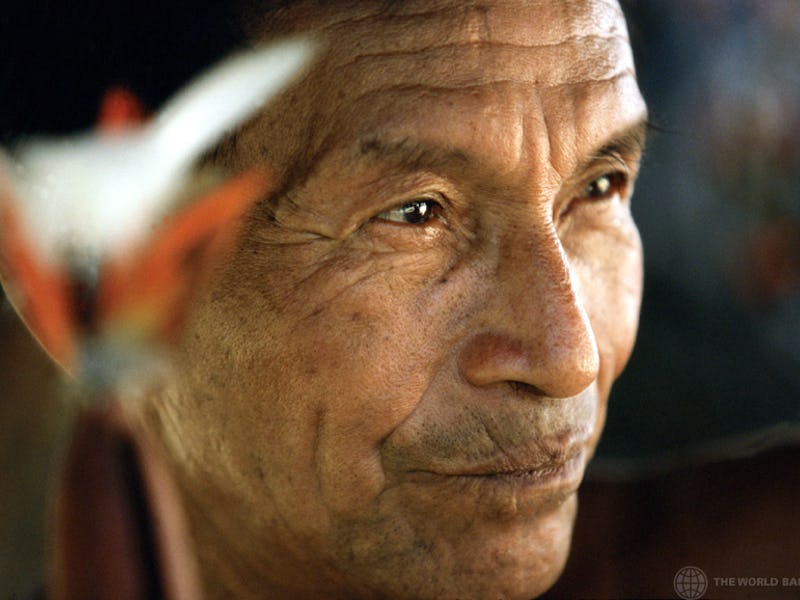Jungle Ritalin Works and No One Is Selling It
In the Amazon, a carefully cultivated sedge grass gives hunters an edge -- and makes them better singers as well.

In Peru, native tribes like the Matsigenka have a not-so-secret weapon that improves concentration, hand-eye coordination, and visual acuity while also healing wounds in an environment that facilitates infection. The substance is a sedge grass called piri-piri (no relation to the delicious Portuguese chicken sauce) and its cultural importance is nearly impossible to overstate, which makes its eventual export seem inevitable.
Hunters chew piri-piri when targeting particularly quick or elusive prey, like spider monkeys. Though anthropologists long credited Amazonians enthusiasm for the stuff to the placebo effect, more research has shown that the substance has very real effects. So what exactly is it and why hasn’t it been culturally appropriated by legions of millennials already? Eager to find out, Inverse spoke to Glenn Shepard, an ethnobotanist, medical anthropologist, and filmmaker who has studied (and ingested) the substance.
He’s a fan.
A Peruvian hunter takes aim. Hunters chew piri-piri to give them an edge against quick prey, like spider monkeys.
What is piri-piri traditionally used for?
It’s used for everything. There are dozens of uses: hunting, love charms, charms to change behavior, to sing better, to protect from enemies, to treat wounds, for fertility, as [birth control], to treat arrow wounds and snake bites. The tendency is to dismiss that as superstition — ‘Oh, they use it for 20 different things, sometimes even opposite things, to have children and also to not have children.’
But there’s actually good science behind most or even all of these effects, right? How does that work?
Piri-piri is in the same family, the same genus as papyrus. And that is a family that, everywhere else in the world, is not used for medicine or known for its medicinal components. But what’s going on here [has to do with] ergot. Ergot is a fungus that grows on rye grain. In the Middle Ages, it would contaminate bread and cause gangrene. It would cause spontaneous abortions. It increases uterine contractions and constricts blood vessels. It causes hallucinations. There’s a theory that the Salem witch trials happened because of ergot-[induced] visions.
In [the States] it’s called rye grass. Cattle ranchers in Texas hate it. So rye grass, sedge grass, naturally has a little bit of ergot in its root. When cattle eat it, they go crazy, they get dizzy, they drown, break their legs. The three main effects of ergot are that it constricts blood vessels, causes abortions, uterine contractions, and it’s psychoactive. So with snake bites and arrow wounds, it constricts so the venom can’t enter the bloodstream, and you don’t bleed. Vasoconstriction increases concentration [of hunters] at the moment of the kill. Ethnobotanists ignored a lot of it as superstition, but the uses are actually very coherent with the properties of ergot.
Okay, but what about the singing?
It’s about confidence. Women take a certain strain of piri-piri to be able to spin cotton really really fine — it gives that extra concentration. There’s a variety for hunting fish, a variety for [hunting] monkeys, one for cotton, one to calm a guy who’s a mean drunk, one to put children to sleep…
How do they engineer it in this manner?
What indigenous people in South America use, it’s not actually the plant. The plant is primitive. But the sedge grass is used as a matrix for growing ergot. By planting the root over and over, they’ve selected for higher and higher concentrations of ergot fungus, to the point where the plant doesn’t even reproduce on its own anymore. When you look at piri-piri, the flower’s gone; you can’t even identify it botanically anymore. So they just keep cloning it from these bulbs.
People can use it as eye drops, right? How do they normally take it?
For hunting, they chew it right before they take the shot. It’s a really fast response like that. They chew and spit it out. They also spit it onto the wound or affected area. For babies, they put it in a pot of warm water and let it soak, and then you bathe people with that. You can put it in the eyes, but its usually chewed or put straight onto the skin.
Is it possible to overdose on it?
There are varieties they talk about where they say if you eat if you’ll go crazy forever. They’ll say this variety cures insanity or makes you become a fearless warrior — so fearless you can actually end up killing yourself. Piri-piri has no long-term bad effects, but ergot itself is very toxic.
You’ve taken it — can you describe the experience?
When I took it for a headache, the headache went away instantly. And then I found that I could juggle really, really well. There’s that slight psychoactive effect that makes you focused and increases hand-eye coordination. It’s not like you’re seeing fractal rainbows; it’s subtle. I was just sort of messing around and then I thought, ‘Wow, I’m juggling better than I’ve ever juggled before.’ It heightened my senses, made everything clearer and crisper, my perception was enhanced. It wasn’t super powerful, but it definitely heightened things. It was intense focus for about 15 minutes.
Is it commercially available? Do you ever see it used outside the kinds of traditional contexts we talked about?
Not [in the States]. In Brazil, there’s a cosmetic company; it’s used as a perfume there. They powder it and mix it with patchouli. There’s a body oil, there’s a beer.
This interview has been edited for brevity and clarity.